The Power of Price-Down Reporting
When there’s a pricing problem at your company, you know it. Still, you struggle to pinpoint what, exactly, the problem is—and how to fix it.
One critical step towards gaining visibility into your pricing issues is something we like to call “price-down reporting.” In this article, we’ll talk about what that term means, and how to use it to your advantage.
What Is Price-Down Reporting?
Price-down reporting allows you to track concessions and identify where discounts are deviating from your set standards. Here’s how it works.
- Each month, data is downloaded directly from your ERP system into a pricing business application like DRIVE .
- For each customer transaction, the application identifies the last time the product was purchased by the same customer, and at what price.
- If the previous transaction commanded a higher price, the current transaction becomes a “price-down.”
Let’s look at this in practice. One of your customers purchases product X at a net price of $45 per unit in May. Your data shows that the last time this customer purchased product X, in December, they paid $50 per unit. This makes the May purchase a price-down transaction of $5. Combining this price-down impact of $5 with the number of units sold, you can calculate the overall impact to the business of allowing the price concession.
Your pricing business application feeds this data into a report that aggregates all transactions, giving you a better grasp of the big-picture pricing environment. You can also filter the data in a variety of ways: by customer, product, or even geography. We find that price-down reports can be an eye-opener for many of our clients.
What Is the Value of Price-Down Reporting?
Why are price-down reports so valuable? Namely, because they show where and when price leaks happen with impressive granularity. These insights allow you to establish accountability levels within your organization, helping to prevent ineffective pricing behavior and put profitability front and center.
Here are three key benefits of price-down reporting.
- Gain a better understanding of price concessions. If you’ve established a market-appropriate price and the the right discount structure, price concessions should be rare. If they’re not, it’s paramount to find out why. To that end, it’s crucial to validate the transactions in your price-down reports. Some may have reasonable explanations, such as promotions.
- Use actual invoice data. Another valuable aspect of the price-down report is the use of actual invoice data. This allows you to easily look up transactions in your ERP system to find specific sales order details and get more insight into why the price-downs are occurring.
- Create urgency with more relevant information. Unlike other reports that highlight transactions that happened two years ago, price-down reports highlight transactions that may have happened as recently as two weeks ago. This timeliness can create the urgency your department needs to take action, now.
How Does Price Down Reporting Work in Action?
Here’s a scenario that illustrates the power of price-down reporting.
One of our clients, a leading global distributor, was struggling to meet its budget every month. Figures were down by both product line and by country. The company knew there was a problem but lacked the reporting ability to find out what was causing the problem.
Using DRIVE’s price-down reporting feature, management was able to drill down into specific problem areas. The data showed that the largest customers were getting exceptionally large volume discounts, above and beyond the discount structure set by management.
While this was already an area of concern, the specific data becoming available made it possible for management to quickly implement key changes. Country managers are now responsible for reporting on price-downs to the central management team, and the company regularly measures the impact of pricing across the entire organization. Finally, management is now able to track month-over-month improvements in KPIs like pricing exceptions and customer profitability.
As a result of implementing price-down reporting, the organization now enjoys a level of accountability it had previously been lacking. In the first three months of the project, the company made significant financial gains. In addition, everyone involved—from managers to sales reps—has a newfound sense of confidence about the strategy moving forward.
Is Price-Down Reporting Common?
It can be difficult to produce price-down reports without the right pricing business application. Many companies don’t have the ability to track and analyze transaction-level data. And adding this capability to your existing ERP system can be expensive—our clients have seen quotes north of seven figures.
The challenge lies within the way the data must be manipulated and interpreted from a pricing standpoint. We’ve developed DRIVE to be able to gather an extremely large number of transactions, accurately match them to one another, and compare and analyze them according to nearly any criteria you want to see.
Price-down reports must incorporate your business rules and logic surrounding pricing and discount structures, as well as the full range of possible product configurations and other changeable factors that could influence the net price of a transaction. Finally, the data must be extensively cleaned and validated to ensure its being presented in the correct way for your company.
This simply goes beyond the capacity of most ERP systems. To further add to the dilemma, large organizations that have grown through mergers or acquisitions must often contend with multiple ERP systems. Merging complex data from disparate systems into a single, consolidated view can be next to impossible.
Finding a pricing-specific business application can solve this problem. Of course, the process doesn’t end there. Price-down reporting is really just the beginning of an ongoing conversation about pricing. However, armed with the insights price-down reporting can provide, you can begin making changes that will allow your company to evolve to the next level of profitability.

